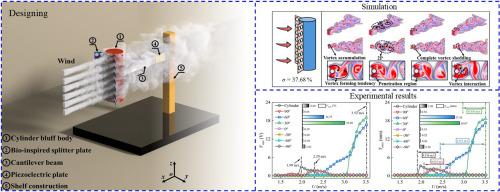Enhancing energy harvesting performance by installing bio-inspired splitter plates
IF 9.4
1区 工程技术
Q1 ENGINEERING, MECHANICAL
International Journal of Mechanical Sciences
Pub Date : 2025-09-10
DOI:10.1016/j.ijmecsci.2025.110820
引用次数: 0
Abstract
Flow-induced vibration (FIV) energy harvesting technology offers a promising solution for powering sensors in Ubiquitous Sensor Networks (USN), but its low efficiency poses a significant challenge to self-powered sensing. To address this issue, this study proposes a novel vortex-induced vibration piezoelectric energy harvester by installing the bio-inspired splitter plates (VIVPEH-B) based on the pore structure of gill lamella to improve the energy harvest efficiency and realize flow control. The experimental results demonstrate that installing the bio-inspired splitter plates with appropriate angles and porosity can effectively enhance the energy harvest performance of the PEH. Analysis of the flow field by the computational fluid dynamics (CFD) method reveals the internal mechanism by which installing bio-inspired splitter plates influences the energy harvest performance of the PEH and quantitative analysis of the flow control was achieved through spectral analysis. Furthermore, the proposed VIVPEH-B can drive a temperature sensor system for real-time environmental monitoring in experiments, enables the realization of self-powered sensing. In summary, installing the bio-inspired splitter plates can effectively enhance the energy harvest performance of the PEH, providing a viable solution for self-powering sensing in USN.

通过安装仿生分离器板提高能量收集性能
流激振动(FIV)能量收集技术为泛在传感器网络(USN)中的传感器供电提供了一种很有前途的解决方案,但其低效率给自供电传感器带来了重大挑战。针对这一问题,本研究提出了一种新型涡激振动压电能量采集器,通过安装基于鳃片孔隙结构的仿生分流板(VIVPEH-B)来提高能量采集效率并实现流动控制。实验结果表明,安装合适角度和孔隙度的仿生分流板可以有效地提高PEH的能量收集性能。利用计算流体力学(CFD)方法对PEH的流场进行了分析,揭示了安装仿生分流板影响PEH能量收集性能的内在机理,并通过谱分析对其流动控制进行了定量分析。此外,所提出的VIVPEH-B可以在实验中驱动温度传感器系统进行实时环境监测,实现自供电传感。综上所述,安装仿生分路板可以有效提高PEH的能量收集性能,为USN中的自供电传感提供了可行的解决方案。
本文章由计算机程序翻译,如有差异,请以英文原文为准。
求助全文
约1分钟内获得全文
求助全文
来源期刊

International Journal of Mechanical Sciences
工程技术-工程:机械
CiteScore
12.80
自引率
17.80%
发文量
769
审稿时长
19 days
期刊介绍:
The International Journal of Mechanical Sciences (IJMS) serves as a global platform for the publication and dissemination of original research that contributes to a deeper scientific understanding of the fundamental disciplines within mechanical, civil, and material engineering.
The primary focus of IJMS is to showcase innovative and ground-breaking work that utilizes analytical and computational modeling techniques, such as Finite Element Method (FEM), Boundary Element Method (BEM), and mesh-free methods, among others. These modeling methods are applied to diverse fields including rigid-body mechanics (e.g., dynamics, vibration, stability), structural mechanics, metal forming, advanced materials (e.g., metals, composites, cellular, smart) behavior and applications, impact mechanics, strain localization, and other nonlinear effects (e.g., large deflections, plasticity, fracture).
Additionally, IJMS covers the realms of fluid mechanics (both external and internal flows), tribology, thermodynamics, and materials processing. These subjects collectively form the core of the journal's content.
In summary, IJMS provides a prestigious platform for researchers to present their original contributions, shedding light on analytical and computational modeling methods in various areas of mechanical engineering, as well as exploring the behavior and application of advanced materials, fluid mechanics, thermodynamics, and materials processing.
 求助内容:
求助内容: 应助结果提醒方式:
应助结果提醒方式:


